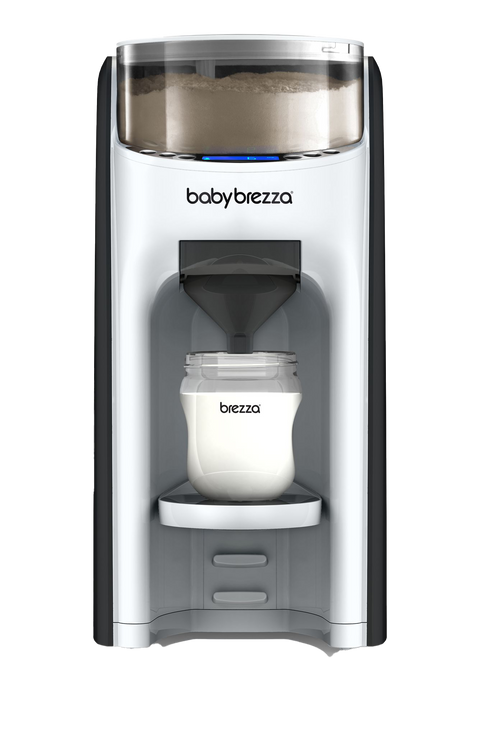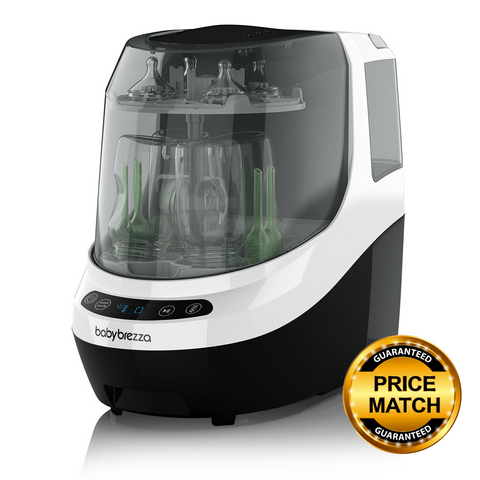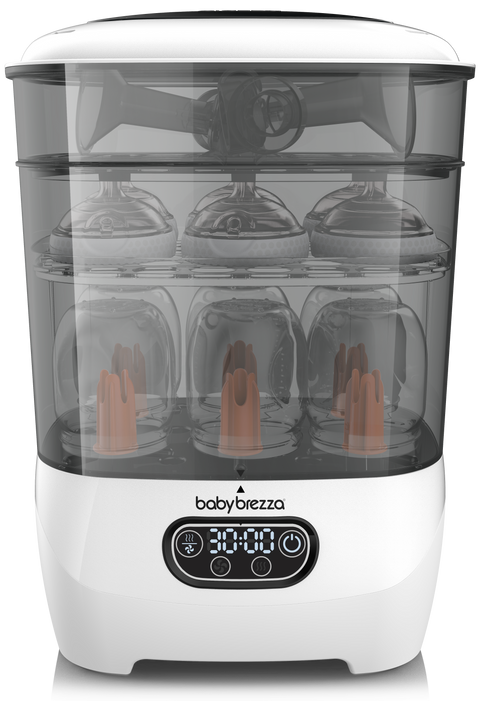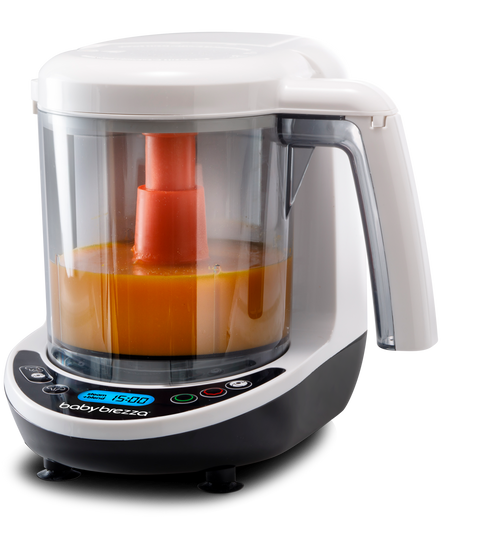There’s a lot to think about when it comes to feeding your baby. Whether you’re deciding between breastfeeding and formula or figuring out which bottle to buy (before you became a parent, did you realize there were a million of them?), it can all seem overwhelming. In this guide, we break down some of the baby feeding basics to help you sort it all out. We hope our guidance, safety tips, and other information will make feeding your baby during his or her first year a little bit easier.
Breastfeeding vs. bottle-feeding
One of the first choices new moms need to make is whether they will breastfeed or bottle-feed their baby. Breastmilk is easily absorbed and digested and contains a high level of nutrients and natural antibodies. The American Pregnancy Association recommends breastfeeding for most families, and the USDA and WIC programs strongly encourage breastfeeding as well, even if it is just for the first few months.
However, everyone is different, and breastfeeding is not right for everyone for a variety of reasons. If you cannot or choose not to breastfeed, bottle feeding your baby infant formula is a healthy option. Formula is made to provide all the nutrients your baby will need. The choice to nurse or bottle-feed is a personal one and something to discuss with your partner and your doctor.
Choosing the right bottle
Whether you’re formula feeding exclusively, transitioning your baby to a bottle, supplementing, or feeding your baby breastmilk from a bottle, choosing the right bottle is essential. There are lots of options, and sorting through the choices can be confusing.
Some important features to look for when selecting a baby bottle include:
- Wide nipple – A wide nipple helps your baby easily transition between breast and bottle.
- Anti-colic design – Gas may contribute to colic. A bottle that has an anti-colic design will help prevent your baby from swallowing air.
- Easy to clean – Make life easier for yourself by selecting a bottle that’s easy to clean. A bottle with a wide mouth and only two parts will save you minutes every time you clean and assemble the bottle.
Warming the bottle
While there is no medical reason to warm a bottle of breastmilk or formula before feeding, many babies do prefer it and it’s more similar to breastmilk which is body temperature. Babies may find it comforting, and some parents say their babies have upset stomachs after being fed a cold bottle.
There are several methods for warming breastmilk and formula bottles:
- Place the bottle in warm — not boiling — water for a few minutes. After the bottle is warm, swirl and mix the bottle. Test the temperature on your wrist to ensure it is comfortably warm.
- Run the sealed bottle under warm tap water. Then follow the same directions as above: swirl the bottle and test the temperature.
These two methods are fine, but they have a few drawbacks:
- They take a lot of time! If your baby is crying and hungry in the middle of the night, waiting for a pot of water to warm up is like watching paint dry.
- The tap water method wastes a lot of water — not very environmentally friendly!
- If the water is too hot, you’ll destroy the breast milk nutrients and immunizing properties.
- Use a bottle warmer. This method is a fast, easy, and convenient way to heat a bottle of breastmilk or formula. Traditional bottle warmers use steam to quickly heat up bottles. But if you are heating breastmilk, you shouldn’t use a traditional bottle warmer because steam is too hot for breastmilk and will damage the nutrients in your “liquid gold”. Instead, look for a bottle warmer with a special heat setting just for breastmilk.
One such bottle warmer is the Baby Brezza Safe + Smart Baby Bottle Warmer. It’s the only warmer with two different settings to ensure bottles are safely heated to the right temperature. The Steady Warm setting warms or defrosts breastmilk safely since it uses a warm water bath while the Quick Warm setting rapidly warms formula bottles since it uses steam. Plus it’s the only warmer with Bluetooth so you can use it from your phone.
Precaution - Don’t Warm In a Microwave
While microwave ovens are handy for lots of things, from heating leftovers to making popcorn, they should never be used to warm a bottle of formula or breastmilk. Microwave heating is uneven, and this creates “hot spots” in the bottle’s contents, which could burn your baby’s mouth. The high heat of the microwave can also ruin the vitamins and proteins in breastmilk.
Cleaning and sterilizing bottles
A baby’s immune system is still developing, which is why careful cleaning and sterilizing of bottles is so important. According to the Centers for Disease Control and Prevention, this type of sanitizing is especially critical if your baby was born prematurely, has a weakened immune system or is sick.
Cleaning
Always wash your hands before handling a bottle, nipple, or formula scoop. The Centers for Disease Control and Prevention recommends it, but it’s a step many busy parents skip. Your hands can transfer germs to the bottle that your baby may touch or hold, the nipple that your baby may feed from, or the formula when you scoop it out of the container. After your baby is finished feeding, clean the bottle as soon as possible. Disassemble the bottle and wash every piece — the bottle, nipple, lid, sealing ring, etc. — in hot soapy water. Use a bottle brush, or cloth if you have a wide bottle such as the Baby Brezza Natural Bottle, to scrub out all the traces of milk or formula stuck inside. After cleaning, rinse all the parts and let air dry.
Sterilizing
Unfortunately, soap and water do not kill all the germs that may still be lingering on the surface of the bottle parts. That’s why you still need to sterilize. Experts recommend sterilizing bottles right out of the package, and after each use, at least for the first three months of your baby’s life. You should sterilize your pump parts after every use too.
Here are a few common sterilization methods:
Boiling
- Submerge freshly washed bottles upside down in a large clean pot of water. Make sure the water covers the bottles.
- Bring the water to a boil and boil for five minutes. You should use tongs to push the bottles under the boiling water so all surfaces are boiled
- Turn the heat off.
- Using tongs, remove the bottles from the pot. Be careful not to spill boiling water that has collected inside the bottles during this step
- Place the bottles on a dedicated drying mat or rack and allow to air dry.
Boiling is simple, but it’s a bit cumbersome and time-consuming. And here’s something else many new parents don’t realize: leaving bottles on a non-sterile drying mat or rack to air dry exposes them to germs. Yes, those same bottles you just sterilized could be at risk of becoming contaminated with harmful bacteria that could make your baby sick.
Microwaving
- Place bottles half-filled with water in a clean microwave.
- Microwave on high for one to two minutes.
- Remove the bottles using oven mitts to protect your hands.
- Remove any remaining water from the bottles.
- Let the bottles air dry on a dedicated drying mat.
Again, air drying is not the best way to ensure that your bottles stay sanitized until your baby’s next feeding.
Electric Bottle Sterilizer
Electric bottle sterilizers help keep germs at bay using steam. Forget about getting out a big pot and trying to avoid splashing boiling water all over the place. Most electric bottle sterilizer models are compact, hold several bottles, and sit neatly on your kitchen counter. Some sterilizers also automatically dry too so you avoid using a drying rack that may have germs and bacteria on it.
For example, the Baby Brezza One StepTM Baby Bottle Sterilizer Dryer automatically sterilizes and dries bottles, pump parts, pacifiers, and accessories in one easy step. It kills 99.99% of germs using natural steam in 8 minutes, then dries the items in as fast as 30 minutes. Products stay sterile for up to 24 hours when left in the unopened sterilizer.
When you use a sterilizer that doesn’t dry the bottles, you’ll still have to air dry them on a non-sterile drying rack or mat, which undermines the purpose of sterilizing. The One Step Baby Bottle Sterilizer Dryer eliminates that extra step, saving you time and even more importantly, reducing your risk of recontaminating your baby’s bottles.
Prepare infant formula safely
If you are formula feeding your baby, again, make sure you are following the safety guidelines recommended by the Centers for Disease Control and Prevention, which include washing your hands thoroughly before touching the bottle, nipple, formula scoop, and preparing the bottle.
To eliminate the continual need to dig for the scoop in your can of formula and possibly transfer germs from your hand to the formula and on to your baby, consider using the Baby Brezza Formula Pro Advanced Baby Formula Dispenser. It automatically mixes, heats, and dispenses formula or water on demand so you can make a bottle instantly. After adding a can of formula powder to the machine, it will dispense the powder as needed. You won’t have to touch the scoop or the powder at all. Plus it’s so much faster than mixing and warming a bottle by hand. With the Formula Pro Advanced, you can make a warm formula bottle in seconds.
Follow the formula manufacturer label directions exactly
Formula has to be made with a specific formula-to-water ratio. A formula bottle with too much water will be diluted and may not meet your baby’s nutritional needs. A bottle with an over-concentration of formula may strain your baby’s still-developing digestive system and kidneys, which can cause dehydration.
The Formula Pro Advanced helps provide a consistent way to make a warm formula bottle to precise standards. The machine measures powdered formula by weight, which is specified on the formula can label and is more accurate than measuring formula by hand, which relies upon volume measurement and approximation. Read more about how the formula pro works by clicking here..
Proper formula storage
Once the infant formula is prepared, the Centers for Disease Control and Prevention recommends that it should be consumed within one hour from when feeding begins, and within two hours of preparation. Leaving prepared infant formula out at room temperature can cause it to spoil. If you cannot use it within that time period, refrigerate the bottle and use it within 24 hours.
Any formula left in the bottle after feeding your baby should be thrown away. Your baby’s saliva and the formula can combine to cause bacteria, which could be ingested by your baby the next time you feed your baby with that bottle.
Stock up on burp cloths
Babies are cute, but they sure are messy. Drool, dribbles, and spit-ups are a part of life. That’s why some of the most basic items you’ll need for your little one are burp cloths. Are these the most fancy and high tech products? No. Completely essential? Absolutely. And you’ll quickly realize why the first time you don’t have one on hand when you need to burp your baby. Your freshly dry-cleaned sweater just wasn’t meant to absorb what your sweet baby can dish out.
You can never have enough burp cloths on hand. While they are made to soak up spit-ups, they are also great for wiping up sneezes and food, using as a changing pad, and more.
Burp cloths should be:
Absorbent - Need to absorb all types of moisture
Durable - Look for a thick cloth that will be able to withstand numerous washings
Soft fabric - Should be comfortable for your baby and you
Taking your bottles to-go
Going out for the day? You’ll need a diaper bag with an insulated compartment to keep your prepared bottles chilled so they stay fresh and safe. In 66 to 72 degrees, fresh breast milk can last up to 10 hours. Put an ice pack in the bag if it will be warmer than that or if you plan to be out longer than 10 hours. Remember that the temperature inside the bag will be higher than outside the bag.
Bringing formula bottles? The experts at Enfamil recommend a bag/cooler temperature of 35 to 40 degrees or the bottles should be used within two hours or thrown out.
When it comes to bringing your baby’s bottles with you, the Baby Brezza Ultimate Changing Station Bag is just what new parents need to make their lives easier. It has 17 pockets, including insulated side pockets to keep bottles fresh and easily accessible. The bag has ample room for diapers, lotions, wipes, and more. There’s even an anti-microbial lined pocket for pacifiers. One of the bag’s most unique features is its detachable drop-down changing station that provides a hygienic place to change your baby’s diaper when you’re out and about.
Life does get more complicated with a baby, but it also gets a whole lot more fun. Feeding your baby can be a wonderful bonding experience. And while there are a lot of decisions to make and it might seem intimidating, don’t worry. As always, ask your pediatrician for guidance.
This information does not replace the advice of a doctor. This is not intended to diagnose, treat, cure, or prevent any disease or other medical issues. Please consult your doctor to determine what is appropriate for your baby.







 TikTok
TikTok
Gutebygdsthv yexch and you will see how hi